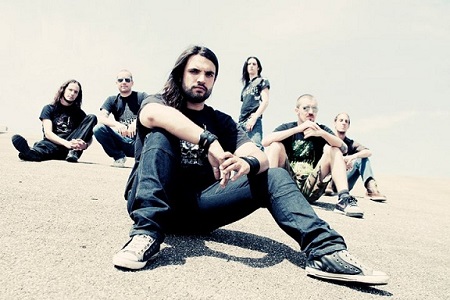(This content originally appeared on Blistering.com)
Coming to America (like the Neil Diamond song) is a big deal for European bands. Just like going to Europe is a big deal for American bands, we reckon. Once a far-fetched prospect in the 90’s, the transcontinental travel ability of underground metal bands has flourished over the last decade, enabling many a worthy European band to hit our shores. So while they’re here, we best give them the red carpet treatment, or they won’t be back. And that’s not cool.
Currently on their maiden voyage of North America with Periphery and The Human Abstract, the Holland’s Textures have every reason to be here, with a killer new album (Dualism) and a searing back catalog of polyrhythmic, Meshuggah-inspired metal. Of the bands following in the footsteps of the legendary Swedes, Textures have always been one of the more palpable, able to balance staccato rhythms with delicate melodies of the streamlined variety. After hitting their stride with their 2004 debut Polars, the band has reeled off a succession of very-capable albums, including 2006’s excellent Drawing Circles and 2008’s Silhouettes, leading up to Dualism.
Buoyed by the addition of singer Daniël de Jongh (who replaced Eric Kalsbeek) and deal with Nuclear Blast, 2011 has been the band’s most successful year, something guitarist Bart Hennephof was more than happy to explain to Blistering during a quick stop in St. Louis…
Blistering.com: You, Human Abstract, and Periphery are a great fit, so it has to be nice to come over for the first time and be hooked up such good bands, right?
Bart Hennephof: Yeah, the package is perfect that way. It’s the same style, but diverse and so all of the fans and our fans like all the bands. Yesterday, I talked to a guy who didn’t know us and came for Periphery and Human Abstract and was blown away by our set. He said it was cool for him to get to know a new band like us.
Blistering.com: Some of the people I spoke to about the tour said they were drawn to the fact it looked like you were having such a good time onstage.
Hennephof: It’s what we always do; it’s natural. You see sometimes with different bands and American bands that are sometimes a bit…how do you say it? Evil or grumpy [laughs]. Our music is a bit like positive metal you could say. We smile and have a good time and run around. We hear a lot of that.
Blistering.com: You’ve been with the band since its inception. Did you think it would take this long to make it over to North America?
Hennephof: It’s a bit long, yeah [laughs]. It’s about time we came over here. We thought about it very well and we wanted to come over when the time is right. It’s a very cool package. You hear a lot of stories about bands that come over and going down physically and financially if you don’t have a good package. This package for us, is perfect to do. Now that we see it’s going so well with turnout and everything. I think there will be a time when we come back again.
Blistering.com: Being on Nuclear Blast has to help with such things, so what type of dividends are you seeing from this union outside of Europe?
Hennephof: Our album is not even released yet, but on this tour you can see the most contacts, which is very great. We have a booking agent in the US, lots of contracts in Europe, so that way, we can grow so much more. There’s also the big distribution they have. The CD will be in stores worldwide, North and South America, which is great.
Blistering.com: For someone who is so heavily involved in the songwriting, it is safe to say that Dualism is the right step to take in terms of your sound after Silhouettes?
Hennephof: [pauses] With this album, we focused more on the sound than ever. We have a lot of space in the sound to create a lot of different layers. The sound is more stretched out; this is the longest album we’ve ever done. We took extra time for the guitar parts, so there’s a lot of different amps and effects and a lot of different guitars. It took a lot of time and was a heavy process, but I think it was worth it. So far, it’s the biggest thing we’ve done right now, but it’s not even the most complex thing we’ve done. It’s not as technical as Polars, for example. We did it this way because we wanted to see how it would sound if we kept the space open. If we had a good vocal line, we really wanted the melody in the spotlight instead of going from riff to riff in three seconds.


